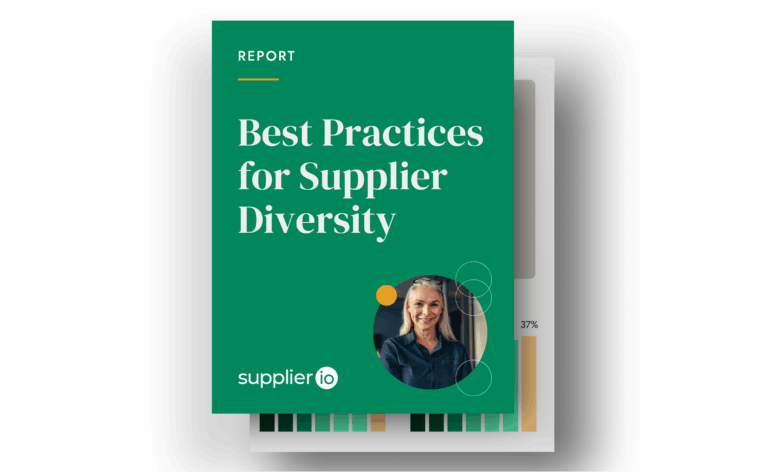Setting a Strong Baseline and Industry Benchmarks for Your Supplier Diversity Program
In a recent Supplier.io webinar, experts discussed why data accuracy is often underestimated and how programs can benefit from industry benchmarks.

For any supplier diversity program to succeed, you need accurate data to track and monitor which of your suppliers are currently and truly diverse and identify how you’re working with them.
This is fundamental. Unfortunately, many companies are building their programs on broken and inaccurate data, as much as 50% inaccurate data. Establishing a clear baseline and benchmarking your program against industry standards are essential steps to ensure growth, track progress, and demonstrate impact.
In a recent Supplier.io webinar, experts discussed why data accuracy is often underestimated and how programs can benefit from industry benchmarks. The discussion made it clear that a solid, accurate foundation is the key to setting achievable goals and demonstrating real value. And the good news is that this is more possible today than ever.
The hidden challenge: data accuracy
Most supplier diversity programs rely on massive datasets that cover a wide range of suppliers and spending categories.
However, as Molly O’Brien from Supplier.io highlighted during the webinar, many companies aren’t working with clean, up-to-date data.
Inaccuracies are often caused by outdated supplier certifications or incomplete profiles. This can lead companies to overestimate their progress by as much as 50% or understate by up to 20% from missed suppliers, making it harder to identify gaps and opportunities for improvement.
Bryan Wiggins, who leads responsible procurement at Cisco, shared a critical insight: “The numbers don’t lie. Investors and customers want real proof of progress, and when you present data, it has to hold up to scrutiny.” This kind of data accuracy is often overlooked, but it plays a critical role in securing internal buy-in and external recognition for your program.
Getting an accurate baseline: why it’s critical
A baseline isn’t just a one-time snapshot; it’s the starting point for tracking your supplier diversity program’s progress over years. Without a clear, accurate picture of where your organization stands, you’ll open yourself up to reputational risk, struggle to measure improvements, or identify where you’re falling short.
Setting a baseline involves asking the right questions:
- What percentage of your suppliers are truly diverse?
- Do you know which suppliers are certified, and are those certifications current?
- How are these suppliers categorized in terms of spend and strategic importance?
This detailed analysis forms the backbone of a successful supplier diversity strategy.
Supplier.io’s data enrichment tool can help procurement leaders clean up and enrich their supplier data, ensuring that certification statuses, ownership details, and demographic information are current and accurate. This tool continuously updates your supplier database, giving you confidence in the accuracy of your baseline data.
Benchmarking: setting realistic goals
Once a solid baseline is established, the next step is goal setting. Industry benchmarks are the best way to ensure your goals are both ambitious and realistic. Setting targets based solely on internal data can lead to misaligned expectations, either aiming too high or too low. Benchmarking your performance against industry standards helps you understand where you stand relative to competitors and peers.
During the webinar, Wendy Rocco from Associated Materials emphasized how benchmarking helped her team set clear, data-backed goals.
“We compared our metrics with industry leaders and identified areas where we were lagging. This gave us the insight we needed to push our program further and close the gaps.”
Supplier.io’s benchmarking tool is designed to help you compare your supplier diversity performance against your industry peers. By analyzing trends and results from other organizations, you can identify areas of opportunity and set informed, strategic goals for growth. This tool ensures that your targets are not only achievable but competitive in your industry.
How to enrich your data for accuracy
Improving your baseline data through data enrichment is critical to establishing a true understanding of your supplier diversity efforts.
Many companies rely on vendor self-reporting, which can introduce errors. Supplier.io’s data enrichment tool verifies and updates supplier information, ensuring you have the most accurate data possible. This includes confirming ownership, tracking certifications, and even identifying suppliers you may not have previously recognized as diverse.
This process transforms your supplier data from a static record into a dynamic, evolving resource that accurately reflects the diversity of your supply chain. Once you’ve enriched your data, you can move forward confidently, knowing that your baseline is a true representation of your current state.
Continuous improvement: tracking progress over time
Establishing an accurate baseline and setting industry benchmarks isn’t a one-time process. Supplier diversity programs, like any business initiative, require continuous monitoring and improvement. During the webinar, both Wiggins and Rocco stressed the importance of revisiting metrics regularly. Rocco shared that her team conducts quarterly reviews to assess progress and make adjustments as needed.
The key to long-term success is continuously refining your data and comparing your performance to industry trends. Tools like Supplier.io’s data enrichment and benchmarking solutions provide the ongoing support you need to ensure your supplier diversity program stays competitive and impactful.
Conclusion
Building a successful supplier diversity program begins with setting a solid baseline and leveraging industry benchmarks. Many organizations fail to realize the impact of data inaccuracies until it’s too late, leading to misaligned strategies and missed opportunities.
By utilizing Supplier.io’s data enrichment and benchmarking tools, you can ensure that your program is built on accurate data and that your goals are aligned with industry standards.
If you’re looking to take your supplier diversity program to the next level, now is the time to assess your data accuracy. Ask yourself: Is your baseline truly accurate? And if not, consider how Supplier.io’s solutions can help you get there.
Ready to set a strong foundation for your supplier diversity program? Reach out to our experts today.




